Technical Description of Nike Adapt BB
By Syed Ali
The City College of New York
Table of Contents:
Introduction:
- 1.1 Nike Adapt BB Page 3
- 1.2 The Designer: Tinker Hatfield Page 3
- 1.3 The Purpose of the Shoe in this Landscape Page 4
Nike Air Adapt BB in the Making:
- 2.1 The Upper Page 4
- 2.2 Cushion/Midsole Page 5
- 2.3 Laces/Lacing System Page 6
- 2.4 Motor Page 6
- 2.5 The Bluetooth Module Page 8
- 2.6 Buttons and LED Power Indicator Page 8
Conclusion: Page 9
References: Page 10
Introduction:i
1.1 Nike Adapt BB:
Figure 1: Nike Adapt BB (Sneaker)
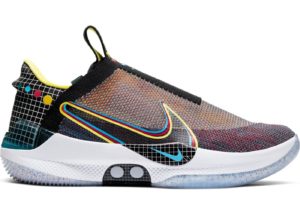
Throughout its golden age the sneaker industry has had its fair share of innovations. From the Chuck Taylors back in the early 20th century to the Air Jordan line in the mid 1980s, there has been a steady growth of performance capabilities in sneakers. The need for such growth came when broadcasted sports became popularized and athletes needed their equipment to provide more performance benefits. Sneaker performance is especially important in a sport like basketball where there are players of different sizes who have different needs. Bigger players require more cushion and smaller players require more mobility and court-feel. There has not been any shoe that even aspired to cater to the needs of every player until the debut of the Nike Adapt BB in 2019, a self-lacing automated sneaker that is said to conform to the players foot before or during the game. Although it’s one of the first of its kind, it has served its purpose well and has opened the door to more innovation in this field.
1.2 Tinker Hatfield
The designer of the Nike Adapt BB is Tinker Hatfield. He is most known for his work on the most popular Air Jordan models and Nike Air Max models. Tinker is considered by many as the greatest designer of all time because of his repertoire of successful projects. Some of the most successful sneaker models today including the Nike Air Jordan 3 and the Nike Air Max 1 are his doing. The Nike Adapt BB is no different as Tinker was head of design.
1.3 The Purpose of the Sneaker
With players becoming larger and stronger, there comes a need for more specific shoes. The NBA is as diverse as it has ever been in terms of body type and with this diversity comes an expectation for more inclusive equipment. The Nike Adapt BB, being the first of its kind, provides a means of customization based on player preference. For example, if a player has a wide foot, he or she can quickly lessen the tension of the laces making the sneaker more spacious. If a player has narrower feet, the laces can be tightened quickly to provide a snugger fit. Also, while playing a running intensive sport like basketball, a player’s foot may expand during the game and players may need to quickly adjust the tension. So far through its lifespan, the most notable players who have donned the Nike Adapt BB are Jayson Tatum of the Boston Celtics and Kyle Kuzma of the Los Angeles Lakers. According to his interview with NBA hall of famer Paul Pierce, it is evident that Jayson Tatum is pleased with the sneakers and the degree of customization he has with them.
Nike Adapt BB in the Making:
2.1 Upper
The Upper of the Nike Adapt BB consists of its renowned fly-wire technology knit onto a fuse base. Nike Fly-wire consists of nylon, tightly knit so it provides a light but durable fit that gives the player flexibility. Fuse is a composite material made by Nike using three different polymers to ensure stability, durability, and breathability. The fuse base adds stability and durability in the event that the fly-wire rips and exposes the lower layers of the upper. The fly-wire is stabilized as the ends of the shroud are tightly knit into the base of the sneaker. In order to completely remove the shroud, an X-acto knife or a similar instrument is required. These were the perfect materials to support the self-lacing mechanism as they are flexible enough for the lacing system to restrict but are tough enough such that the upper does not rip.
Figure 2: Deconstructed Fly-wire Figure 3: Nike Adapt BB Deconstructed

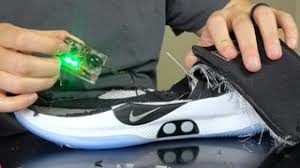
2.2 Cushion/Midsole
Surprisingly Nike did not use its most coveted cushion set up for this model. Because of the hefty price tag at $350, it was assumed that Nike would use one of its flagship cushioning systems such as zoom air or react. Instead this sneaker features a full length Cushlon setup. Cushlon is a foam consisting of a high-volume rubber that is light and provides good feedback and a low-profile ride. Although it doesn’t provide the best impact protection, it is comfortable and is noticeable underfoot. The entire midsole of the sneaker consists of Cushlon and through wear and tear the foam compresses and that can be seen through the creases. Cushlon’s low profile and light rubber composition pairs well with the heavy motor and battery embedded in the midfoot of the sneakers. Also, Cushlon is slightly firmer than other more coveted cushioning systems such as Lunarlon, ensuring that the motor and the lacing mechanism aren’t affected by impact.
Figure 4: Cushlon Midsole

2.3 Laces/Lacing System
The Nike Adapt BB doesn’t require a manual way to tighten the shoes. Everything is done seamlessly through the application or the buttons on the side of the sneakers. The sneakers feature cables knit underneath the upper of the shoes. The ends of the cables are connected the motor which spins in the direction in which the user wants, tightening and loosening the shoes. The cable tightening setup allows for an all-around lockdown of the foot when tightened. The only limitation of the cables is the lack of customization in terms of which part of the foot should be tighter or looser.
Figure 5: Power Lacing System Figure 6: The Motor
 .
. 
2.4 The Motor
The selling point for the Nike Adapt BB is its ability to be instantly laced and unlaced with a press of a button. Arguably the most pivotal component in performing this task comes in the form of a motor located in the midfoot of the sneakers. Underneath the insole, cut into the Cushlon midsole lives the motor by which the sneaker lacing system operates. The motor is protected by two thick Velcro straps to ensure that the impact of the foot does not damage the pulley system at the top of the mechanism. The motor is also protected by a thick plastic cover with the Nike logo on it. All these precautions were taken for the sake of safety as the contents of the motor can be flammable under certain conditions.
Figure 7: The Copper Coils

The motor consists of the battery, the wireless charging copper coils, the Bluetooth module, the circular turning mechanism, and a push button switch. The most important part of the motor is the circular turning mechanism at the top. Underneath the plastic encasing the mechanism consists of metal and is connected to the battery at the very bottom of the motor. The power from the battery turns the inner component of the mechanism either clockwise or counterclockwise, depending on the chosen switch. The inner component is connected to a circular black plastic cup which interlocks the ropes which connect to the laces of the shoes. This circular cup spins with the turning of the mechanism to loosen or tighten the sneakers. The black cup and inner component of the mechanism are secured by two screws at the top along with two washers at the bottom. The motor includes a small battery, capable enough to carry out these tasks for 12 hours without another charge. Underneath the battery there are copper coils that allow for the wireless charging to occur. Copper coils are the most popular form of wireless charging among most devices. It relies on the electromagnetic field between the two copper coils which transfers energy between the charging pad and the battery. All these components can be seen in figure 8, a deconstructed model of the motor.
The motor is mounted onto the midsole of the sneakers by way of a two-piece setup. There is a plastic mold the size of the motor that is fit into a similar cutout on the rubber outsole. The bed of this cup has a hex pattern to absorb the impact from the ground and prevent it from hitting the motor. Likewise, the bed of the outsole also has this similar pattern which serves the same purpose.
Figure 8: Deconstructed Motor/Velcro Placement/Motor Cover

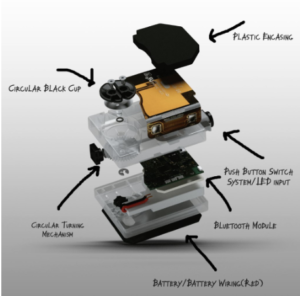
2.5 The Bluetooth Module
In between the turning mechanism and the battery lies the Bluetooth module. Bluetooth, an already established process works over a 79 channel 2.4 Ghz radio. The module consists of a radio transmitter, a motion sensor, and some type of memory flash or RAM. The radio transmitter allows for the connection between two devices to exist and the motion sensor allows for users to keep track of certain fitness information through the Nike mobile application. The extra memory is present to carry out the functions of the application prompted by the user. The module is connected to the main power source and circuitry, so users can change the tension of the laces from the application without pressing the physical buttons. The Bluetooth module is not the most essential component to the sneakers as its malfunction will not hinder the rest of the parts.
Figure 9: The Bluetooth Module
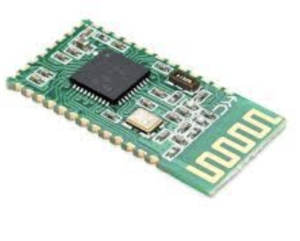
2.5 Buttons and LED Power Indicator
Figure 10: LED Lights/Buttons
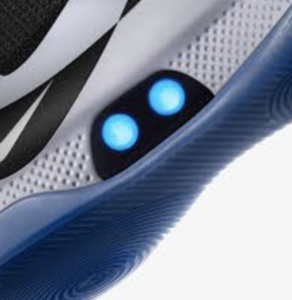
As mentioned before the motor includes a push button switch. A push button switch is very important as it opens and closes the circuit based on the users need. When the button is pressed, a metal spring meets two wires, allowing the electricity to flow to the different parts of the mechanism. In this case the push button switch faces outwards towards the medial side of the sneakers. The switch is connected to the two physical buttons on the exterior medial side of the sneakers. The buttons allow for the tightening and loosening of the shoes and are the input stream for the tightening system. The buttons are made of a rubber compound and house led lights to indicate the power level of the sneakers. The use of rubber for the buttons is paramount as it allows for tactility and lightness
Conclusion:
Despite the notions that the Nike Adapt BB uses very simple technology, the making of the shoes required a very thought out design. The building of the motor itself was not the hard part as the mechanism only consisted of a power to pulley system. Finding the correct design and implementing the technologies in the shoes likely provided more of a challenge. Designers had to engineer the shoes in a way where the mechanism could be placed without being at risk for breaking or catching on fire. Although it is not widely used in the world of basketball, slowly as Nike garners competitors in the field, the concept will become more popular and players will have more access to sneakers of this nature. Also, with more production prices will drop and it will be realistic for the average consumer to buy this. The Nike Adapt BB has already opened doors towards a more seamless sneaker experience.
References
Hyperfuse technology. (2011, June 13). Retrieved from https://news.nike.com/news/hyperfuse.
Nike Flyknit. (n.d.). Retrieved from https://sneakernews.com/category/nike-flyknit/.
Breaking Down the Nike Adapt BB. (2019, January 15). Retrieved from https://news.nike.com/news/nike-adapt-bb.
How does Bluetooth work? (2018, July 5). Retrieved from https://www.explainthatstuff.com/howbluetoothworks.html.
Chris [Weartesters]. (2019, February 24). NIKE ADAPT BB [Video File]. Retrieved from https://www.youtube.com/watch?v=c41sP_XtjP4&t=111s
Lincoln, Dan [What’s Inside?]. (2019, February 22). What’s inside World’s First Self-lacing Basketball Shoes? [Video File]. Retrieved from https://www.youtube.com/watch?v=hFZKvE9vtKM
(Photograph). (2019, October 01) Nike Adapt BB “Multicolor” [Photograph]
Portland, Oregon: Nike
(Photograph). Flywire [Photograph]Portland, Oregon: Nike
(Photograph). Nike Adapt BB Motor [Photograph] Portland, Oregon: Nike
(Photograph). Nike Air Pegasus 30 Review [Photograph] Solereview
(Photograph). Nike Adapt BB Motor Placement [Photograph] TheVerge
(Photograph). Nike Adapt BB Upper Deconstructed[Photograph] TheVerge


